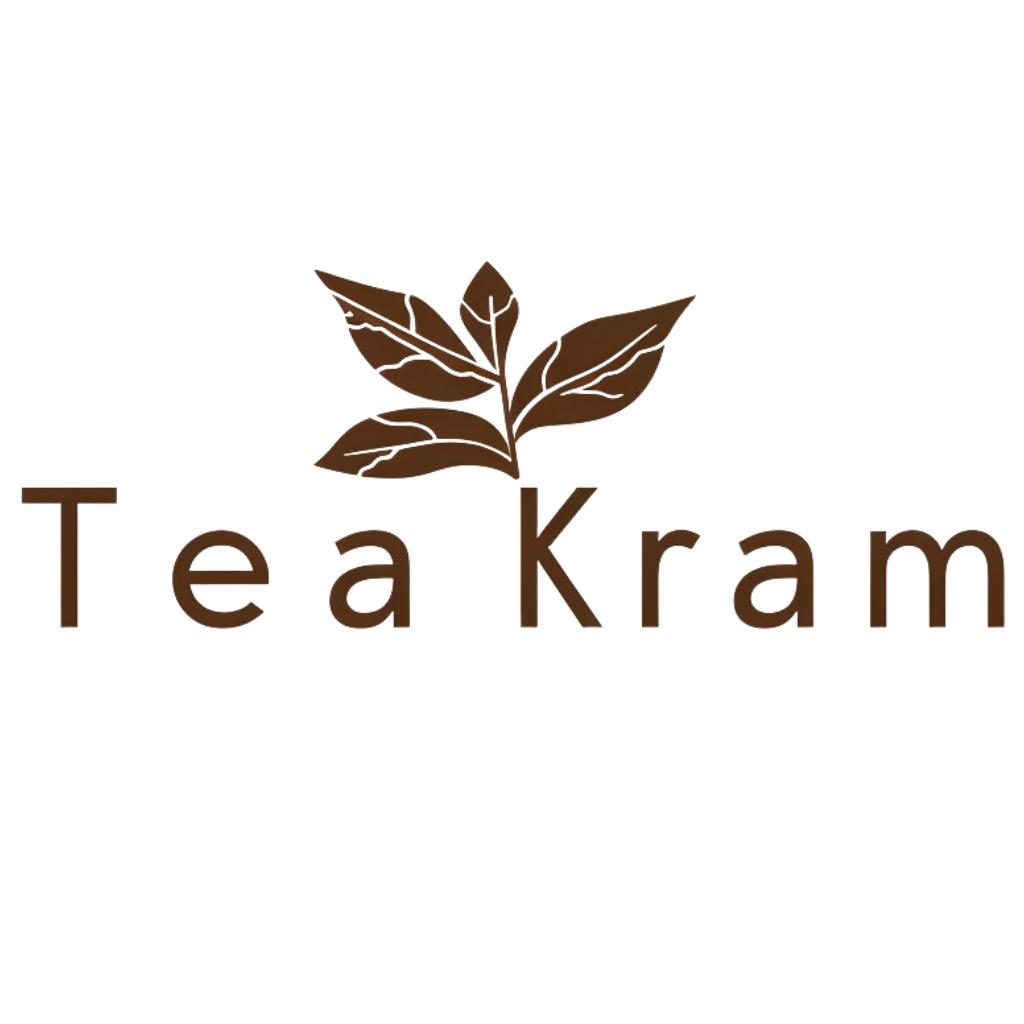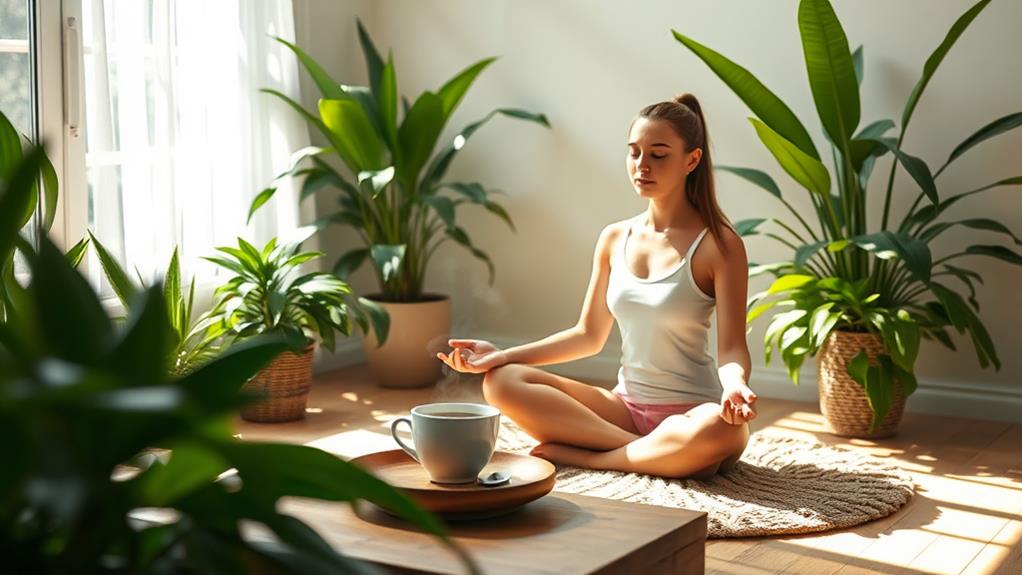Combining tea and meditation can create a relaxing and mindful experience. While sipping warm tea, you can boost your focus and calm your mind. Popular choices like chamomile and green tea can enhance your meditation practice, making it easier to connect with your thoughts. Preparing your tea mindfully, from selecting the right blend to brewing it, can be part of the meditation ritual itself. Setting up a cozy space and practicing deep breathing with each sip can deepen your connection. It's a journey of personal discovery, letting you find what works best for your tea-meditation experience. There's so much more to explore!
The Benefits of Tea
Tea offers a world of benefits that extend beyond mere enjoyment. When you sip a warm cup, you're not just quenching your thirst; you're also tapping into a treasure trove of health perks. For starters, tea can boost your immune system, helping you fend off those pesky colds. It's packed with antioxidants, which fight free radicals and promote overall well-being.
Unlock amazing health benefits of tea, and discover how different types can support your health goals. Who knew something so simple could pack such a punch?
Drinking tea can also enhance focus and clarity. The unique combination of caffeine and L-theanine helps you stay alert without the jitters that coffee often brings. You might find that your thoughts flow more freely, making it a great companion when brainstorming new ideas.
Moreover, tea can serve as a gentle way to manage stress. The ritual of brewing and enjoying a cup can create a moment of mindfulness, allowing you to pause and breathe. It's like a mini-vacation in a mug!
Types of Tea for Meditation
For those looking to enhance their meditation practice, certain types of tea can elevate the experience. Imagine sipping a warm cup of chamomile tea, its gentle aroma wrapping around you like a soft blanket. Chamomile is known for its calming properties, perfect for easing your mind as you settle into meditation.
Additionally, the ritual of preparing and sipping tea can engage your senses, creating a meditative experience that promotes mindfulness and presence, allowing you to connect with yourself and the universe tea serves as a means of connecting.
Another excellent choice is green tea. Packed with L-theanine, it promotes relaxation while keeping your focus sharp. This balance helps you stay present during your practice, allowing deeper introspection.
If you prefer something more aromatic, consider herbal blends like lavender or peppermint. Lavender tea can transport you to a serene garden, while peppermint invigorates your senses, making you feel refreshed and alert.
Finally, don't overlook rooibos tea, which is caffeine-free and rich in antioxidants. Its earthy flavor can ground you, making it easier to connect with your thoughts.
Experimenting with these teas can elevate your meditation routine, enhancing your overall experience.
Preparing Your Tea Ritual
Creating a tea ritual can transform your meditation practice into a deeply personal and sacred experience. To begin, consider the elements that will enhance your ritual. Selecting the right tea, the perfect tools, and setting an intention can bring innovation to this age-old practice.
Here's a simple guide to help you prepare:
| Element | Description | Tips |
|---|---|---|
| Tea Selection | Choose a tea that resonates with you. | Experiment with flavors! |
| Brewing Tools | Use a teapot, kettle, or infuser. | Make it visually appealing! |
| Mindful Intention | Set a clear goal for your meditation. | Write it down for clarity! |
As you gather your materials, take a moment to breathe deeply and focus your mind. Prepare your tea with care, allowing the aroma to fill your space. This process isn't just about sipping tea; it's about creating an experience that sets the tone for your meditation. By weaving these elements together, you'll find that your tea ritual becomes a unique, empowering part of your mindfulness journey. Enjoy the process and let your creativity flow!
Creating a Meditation Space
An inviting meditation space enhances your practice, making it easier to focus and connect with yourself. Start by choosing a quiet corner in your home—somewhere you won't be disturbed. You don't need a lot of space; just an area that feels good to you.
Next, consider the lighting. Natural light is fantastic, but soft lamps or candles can create a cozy atmosphere too. Additionally, incorporating a tea ritual can amplify your mindfulness, as the spiritual journey of tea encourages deeper self-connection.
Now, think about comfort. A cushion or chair can work wonders for your posture during meditation. You might also add a blanket for warmth, especially during chilly days. Surround yourself with items that inspire calmness: perhaps beautiful plants, soothing artwork, or meaningful objects that resonate with you.
Sound is another essential factor. If silence doesn't suit you, play soft music or nature sounds to help you unwind.
Finally, incorporate your tea ritual into this space. The aroma of your favorite brew can elevate your experience and deepen your connection to the moment.
Mindfulness Practices With Tea
When you prepare your tea, think about each step as a chance to practice mindfulness. Engaging in tea rituals can promote a sense of calmness and mental clarity, allowing you to fully immerse yourself in the moment.
As you sip, focus on your breathing; it can transform a simple drink into a calming ritual. By creating a peaceful space around you, you'll enhance this experience and truly enjoy the moment.
Incorporating mindfulness practices associated with tea can help shift your focus away from academic pressures.
Preparing Your Tea Mindfully
In the quiet moments before you brew your tea, take a deep breath and ground yourself in the present. This is your time to connect with the process.
Start by selecting your favorite tea, which can offer exceptional health benefits, such as supporting heart health and enhancing gut health through its rich polyphenols exceptional health benefits. Notice the packaging, the colors, and the aromas. Each tea tells its own story, and you're the storyteller.
As you measure the leaves, feel their texture between your fingers. Pay attention to how they shift and tumble, as if they're enthusiastic to release their flavors.
Next, heat your water mindfully. Rather than rushing, watch the steam rise, and listen to the gentle bubbling. This is a moment of anticipation, so embrace it.
Once your water is ready, pour it over the leaves. Observe how they dance and swirl, transforming the water into a vibrant infusion. Allow yourself to appreciate this transformation.
While the tea steeps, reflect on your day or simply enjoy the stillness around you. By preparing your tea mindfully, you're not just making a beverage; you're creating a moment of peace and clarity.
This practice sets the stage for a deeper experience when it's time to sip. Enjoy the journey!
Sipping and Breathing Techniques
The moment your tea is ready, it's time to truly savor it. Begin by taking a deep breath, allowing the aroma of your tea to fill your senses. This first step is essential; it prepares your mind for the experience ahead.
As you lift the cup, feel its warmth against your palms. This connection helps ground you in the present moment.
Now, it's time to sip. Take a small, mindful sip, letting the tea linger on your tongue. Notice the flavors and textures, whether it's the smoothness of green tea or the boldness of black. Each sip is an invitation to explore and appreciate what you're drinking.
While you sip, practice deep breathing. Inhale slowly through your nose, expanding your lungs fully, and then exhale gently through your mouth. Repeat this process, synchronizing your breath with each sip. This rhythmic pattern not only enhances your enjoyment but also creates a calming effect.
As you immerse yourself in this simple ritual, you'll find that the act of sipping and breathing can transform your tea time into a mindfulness practice, fostering a deeper connection to both your tea and yourself.
Enjoy the journey!
Creating a Calm Space
Creating a calm space for your tea ritual can greatly enhance your mindfulness practice. Imagine a cozy corner where soft light filters through sheer curtains, and the scent of your favorite tea fills the air.
To start, choose a spot in your home that feels inviting. You might add a comfy chair or a cushion on the floor. Surround yourself with elements that inspire serenity—perhaps a small plant, a candle, or a piece of art that brings you joy.
Next, it's time to declutter. A tidy space can help clear your mind, making it easier to focus on your tea and your thoughts. Silence any distractions by turning off your phone or playing soft, calming music.
As you prepare your tea, take a moment to appreciate the colors and aromas. This intentional act sets the stage for deeper mindfulness.
Remember, your calm space isn't just about the physical environment; it's also about your mindset. So, breathe deeply, feel the warmth of your tea, and let your worries fade away.
With each sip, you'll find yourself more present, ready to embrace the quiet moments of your day.
Combining Tea and Breathing Techniques
When you prepare tea mindfully, you can turn it into a calming experience that pairs perfectly with breathing techniques.
By focusing on your breath while you steep your tea, you not only enhance the flavor but also promote relaxation and clarity.
Let's explore how combining these two practices can benefit your overall well-being and create a soothing ritual you'll love.
Mindful Tea Preparation
In the quiet moments of your day, preparing tea can transform into a mindful ritual that harmonizes your breath with each step of the process.
Start by choosing your favorite tea. As you open the package, take a deep breath, inhaling the fragrant aroma. Notice how it feels to embrace this sensory experience.
Next, as you measure the tea leaves, let your mind focus on the task at hand. Feel the texture of the leaves between your fingers.
Pouring water is another chance to connect with your breath. With each pour, synchronize your breathing—inhale as you lift the kettle and exhale as you pour.
While the tea steeps, take a moment to pause. Visualize the flavors melding together, and breathe slowly, allowing your thoughts to settle like the leaves swirling in your cup.
Finally, when it's time to enjoy your brew, take that first sip mindfully. Savor the warmth and taste, feeling grateful for this moment.
Incorporating these simple breathing techniques during tea preparation can elevate your experience, turning an ordinary routine into a revitalizing and innovative ritual.
Enjoy the journey of tea!
Breathing Patterns and Benefits
How can combining breathing techniques with your tea ritual enhance your mindfulness? By integrating intentional breathing while sipping your tea, you can elevate your experience from ordinary to extraordinary.
Start by finding a comfortable seat, holding your warm cup, and taking a moment to appreciate the aroma. As you inhale deeply through your nose, let the calming scent envelop you. Then, exhale slowly through your mouth, releasing any tension.
This simple act of conscious breathing not only grounds you but also helps center your thoughts. You might try the 4-7-8 technique: inhale for four counts, hold for seven, and exhale for eight. This pattern slows your heart rate and promotes relaxation, making you more aware of each sip.
As you sip, focus on the flavors dancing on your palate. This attention to detail turns tea drinking into a sensory journey. With every deep breath, you create a rhythm that enhances your connection to the moment.
Enhancing Focus and Relaxation
Sipping a warm cup of tea can create a serene atmosphere that enhances your focus and relaxation. When you take that first sip, you might feel the warmth spreading through your body, easing tension and grounding you in the moment. This simple act can help you shift your mind away from distractions, allowing for deeper concentration.
The natural compounds in tea, like L-theanine, work wonders for your brain. They promote calmness while keeping your mind alert, making it easier to tackle tasks or reflect during meditation. As you enjoy your tea, try to connect with its aroma and flavor. Each sip can serve as a gentle reminder to stay present and engaged.
Creating a routine around your tea-drinking can also boost your focus. Setting aside a few quiet moments daily to enjoy your tea can become a ritual that signals your brain it's time to concentrate.
You might even find that this practice not only calms your mind but also sparks creativity. So, embrace the experience, and let the soothing qualities of tea guide you toward a more focused and relaxed version of yourself. Happy sipping!
Personalizing Your Tea-Meditation Experience
Tailor your tea-meditation experience to fit your personal preferences and needs. This unique blend of tea and mindfulness can be customized to enhance your journey towards relaxation and clarity.
Here are a few innovative ideas to personalize your practice:
- Choose Your Tea Wisely: Different teas offer unique benefits. Green tea boosts energy, while chamomile promotes calmness. Pick one that suits your mood.
- Set the Scene: Create an inviting atmosphere. Use soft lighting, calming colors, or even your favorite music to enhance your meditation space.
- Experiment with Rituals: Incorporate rituals that resonate with you. Whether it's a specific brewing method or a favorite cup, these elements can deepen your connection to the experience.
As you explore these options, don't be afraid to mix things up! The beauty of tea and meditation lies in their adaptability.
Try new flavors, techniques, or even meditation styles until you find what truly speaks to you. Remember, this journey is yours, and every cup can bring you closer to mindfulness.
FAQ
Can I Meditate Without Drinking Tea?
Absolutely, you can meditate without drinking tea! Meditation's all about finding your focus and inner peace. Explore various techniques that resonate with you, whether it's through breathwork, visualization, or mindfulness practices. Enjoy the journey!
What Time of Day Is Best for Tea Meditation?
Studies show that 80% of people feel more focused in the morning. You'll benefit most from tea meditation then, as the calmness enhances your clarity. Experiment with different times to discover your peak mindfulness moments.
Are There Any Side Effects of Tea During Meditation?
Drinking tea can lead to increased heart rate or jitters if you're sensitive to caffeine. You might also experience digestive discomfort. It's crucial to choose the right type and amount to enhance your meditation experience.
Can I Use Herbal Tea for Meditation?
You can absolutely use herbal tea for meditation; it's like inviting a symphony of flavors into your practice. Choose calming blends, and let their soothing properties enhance your focus and tranquility as you meditate.
How Long Should My Tea Meditation Session Last?
Your session should last about 20 to 30 minutes. This timeframe allows you to immerse yourself fully, fostering mindfulness and relaxation. Adjust according to your comfort, but consistency is key for deeper experiences.
Final Thoughts
In the end, think of tea and meditation as two friends on a journey together. Tea warms the heart, while meditation calms the mind, guiding you to a peaceful oasis amid life's chaos. By creating your own tea ritual and mindful space, you weave a tapestry of focus and relaxation. So, take a moment each day to sip and reflect, allowing these practices to enrich your life, just like a gentle stream nourishes the roots of a mighty tree.



